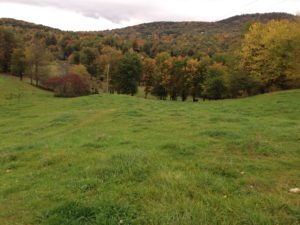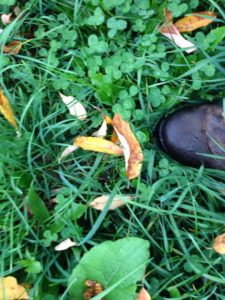Farming with Nature: The Next Agrarian Frontier
by John M. Thurgood
Imagine a world with healthy and abundant food, thriving farmers, and clean lakes and streams. Is this an unrealistic vision? It seems with our abundant resources and knowledge, it should be possible. Why isn’t it? I think the root cause is the belief we need to control nature — to take the upper hand.
Our “man over nature” paradigm has driven our decision making process. In an attempt to control weeds and obtain nitrogen from a green manure crop, we plowed our soils. In short order, the health of our soil degraded and started flowing to the sea. Then, to enhance short-term yields, we adopted the use of commercial fertilizer that has choked our waters with nutrients. Nitrogen from cropland flows to the sea, resulting in algal blooms and hypoxic zones. Phosphorus flows into our streams and lakes and causes algal blooms, rendering recreational uses unattractive and the water less suitable for public drinking water systems.
I could go on at length about the negative effects of our “man over nature” paradigm, but the fact
is our collective decisions have led us to where we are today. The good news is our actions can also lead us to a brighter future. So, how can we make better resource management decisions? I hope you will join me in adopting a new paradigm of “Farming with Nature.”
So how do you farm with nature? I would like to be able to tell you there is a simple, easy to use formula, however, there is no one-size-fits-all answer. It starts with looking across your landscape and asking: “How can I work with the natural resources and systems I have been blessed with to produce food and fiber, while making sure I am giving something back to the net benefit of nature?”
Just where does one begin? I suggest you start at the very top of your landscape, where you can see the entire body of your resources. Imagine you are looking out from your back porch. What do you see? Trees, shrubs, grass, forbs, maybe a lake or stream, domestic and wild animals? Take a mental inventory. While you’re at it, spend the whole day walking around and observing, to get a comprehensive mental list.
Now, if left alone, where would nature move these resources? This type of movement is called
succession in the world of natural science. Succession is defined as “The progressive
replacement of one dominant type of species or community by another in an ecosystem until a stable climax community is established.” (www.bilogy-online.org/dictionary)
The answer to this question is determined by the climate in which you live. Areas where humidity and rainfall are concentrated into short periods throughout the year tend to be brittle; an example would be the Southwestern region of the US. On the other hand, non-brittle areas have relatively high rates of rainfall and humidity distributed throughout the year. The Northeast US is an example of a non-brittle environment. (Allan Savory)
So why is brittleness important to think about? The impact of man’s actions on the land can
have wide ranging consequences depending on the degree of brittleness. The impact of these actions can be predicted. In brittle environments, the presence of large herds of ranging cattle and the associated animal impact and herd effect — means that succession will tend to move toward thriving rangeland. While in non-brittle environments succession tends to move toward forests.
Now let’s return to the view from your back porch. If you live in the Northeast and take no action on the land, when you compare your view from year to year you will see the bare ground, or mono-crop fields, moving toward grasses and forbs, then change to scrub and finally to forest. In succession, nature is moving to more and more diversity. If you want to stop this succession you will have to do something on the land. Keeping the land as a mono-crop takes the most work and expense. You will spend your whole life fighting myriad forbs that continue to try to get a toehold. The lack of plant diversity in a mono-crop leads to a break down in every ecosystem process.
So why would you want to hold succession at the mono-crop level? Well, for one thing, it is hard to produce tomatoes in the forest. If you are a vegetable grower, you may be thinking you have to grow produce by way of a mono-crop. Let’s think about this. How can you grow a mono-crop, but not as a mono-crop? One option is to grow tomatoes and follow them with a cover crop. Or maybe you can grow no-till tomatoes without inverting or stirring the soil. This will help preserve the biological community in the soil. I encourage you to think of other ways you can work with nature.
You may be thinking that holding succession at the mono-crop level seems like a lot of work, and are looking for other alternatives that are farther along the successional continuum. One option is polyculture, which means growing different plants in the same space. This diversity of plant species can help by providing different types of root systems, fibrous and tap roots and they may also have a different canopy or allelopathic capability. As you add diversity the system becomes more stable. Adding the animals to the system is another option.
Let’s start with a little discussion about how animals graze in a natural setting. In the case of bovine, they would be constantly moving around to find lush grass free of urine and manure. To mimic this natural movement, many grazing farmers have adopted some form of rotational grazing. Proper grazing management eliminates the overgrazing of plants, which causes bare ground. It also promotes a diversity of grasses, including deep-rooted grasses and forbs that increase the pumping of mineral resources from deep in the soil, to the soil surface where plants need them. The roots of these forbs also serve to move carbon deep into soil and feed the biological community. All this leads to healthy soil, more productive pastures, and well-functioning ecosystem processes. Now, if you add undisturbed grazing lands or hayland during peak nesting periods, you can also have a positive impact on declining grassland bird populations. These are just a few ways that one can “graze with nature.”
You may be thinking you want to let your land grow back to forest, or at least some of it. You can approach this in many ways. You can just let ’er go, but taking some action now might get you to your desired goal for a healthy forest ecosystem faster. If you have invasive species, you may want to get these under management so seedlings can out-compete them. The stage between crop or pastureland and forest is often referred to as early mid-successional habitat. This is when the land is covered by a diverse set of grasses, forbs, shrubs and trees. In many areas in the Northeast, this habitat is in short supply and has led to declining populations of bobolink, towhee and chestnut-sided warbler. By fostering this habitat you can help bring these species back. Enlisting a forester to develop a plan to meet your objectives for the regeneration and management of existing woodland can pay big dividends.
Let’s go back to the porch. As you look out across the landscape, you may want to consider
doing all of the things we have discussed. If so, it now comes down to deciding about placement. Ask yourself, where do I want to grow vegetables, graze animals, develop early successional habitat and forest land? Having a diversity of land uses is another good way to mimic nature.
There are trained professionals, neighboring farmers and published resources that can help you better farm with nature. Two texts I have found extremely useful in learning how to farm with nature are: 1) Holistic Management, A New Framework for Decision Making, by Allan Savory with Jody Butterfield. The concepts presented in this article are inspired by this book. 2) Permaculture: A Designers Manual, by Bill Mollison. The USDA Natural Resources Conservation Service can provide technical assistance and financial incentives for the adoption of conservation practices.
I truly believe farming with nature is our next agrarian frontier, and we have many farmers throughout the country and the world who are doing it successfully. As editor of the Stewardship and Nature section of the Small Farm Quarterly, I would appreciate your sharing your approach to farming with nature. If you would like to submit an article, send it directly to me at john.thurgood@vt.usda.gov. Our readers and I look forward to hearing from you.
John Thurgood is the USDA Natural Resources Conservation Service District Conservationist for the Central Zone, Vermont.




Amazing blog ways to get fortnite accounts nice
Adopting the Farming with Nature approach emphasizes a holistic view of agriculture advocating for practices like rotational grazing and early successional habitat management to enhance both productivity and environmental health.
Top Plumbing Services in Atlanta